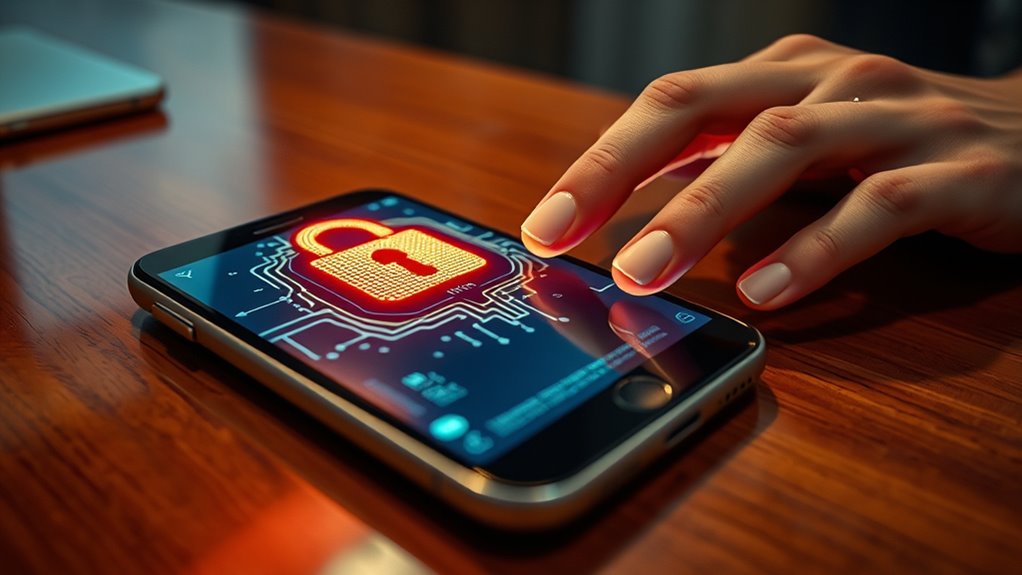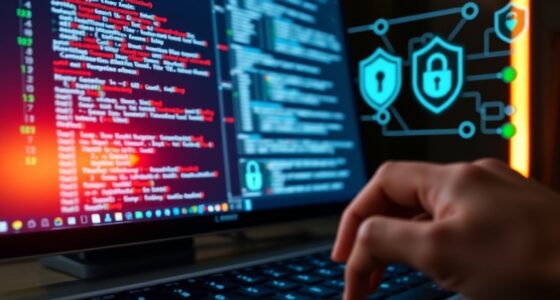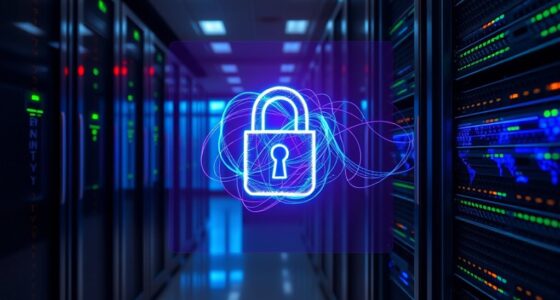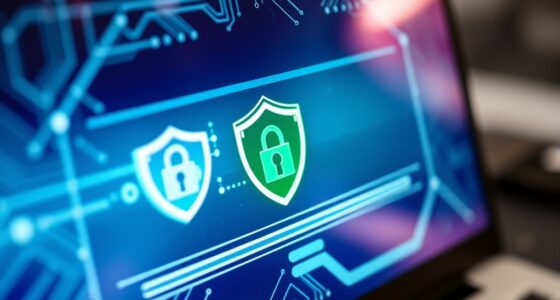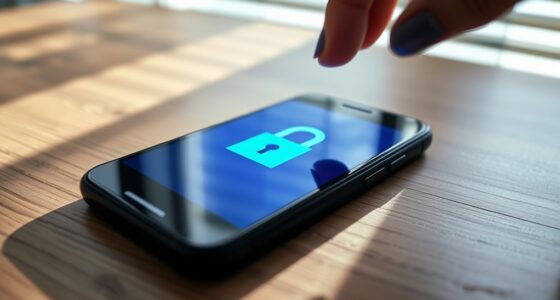End-to-end encryption is a security method that keeps your digital messages private by ensuring only you and the person you’re communicating with can read them. Your messages are encrypted on your device and decrypted on theirs, preventing anyone else—whether hackers, service providers, or governments—from accessing the content during transmission. While it’s a highly secure way to protect your privacy, understanding its limitations and ongoing challenges can help you stay more informed about safeguarding your communication.
Key Takeaways
- End-to-end encryption ensures only the sender and recipient can read messages by encrypting data on the sender’s device and decrypting on the recipient’s device.
- It maintains encryption throughout transmission, preventing third parties like hackers or service providers from accessing message content.
- This encryption method protects user privacy in personal and professional communications, safeguarding sensitive information.
- Implementing end-to-end encryption relies on complex cryptographic algorithms that require ongoing updates for security.
- While highly secure, no system is entirely invulnerable; continuous vigilance and informed usage are essential for maintaining privacy.

End-to-end encryption is a security method that guarantees only you and the person you’re communicating with can read the messages. When you send a message, it’s encrypted on your device and remains encrypted until it reaches the recipient’s device, where it’s decrypted. This process assures that no third parties, including service providers or hackers, can access the content of your conversations. It’s a powerful way to protect your privacy in a digital world where data breaches and surveillance are common concerns.
End-to-end encryption ensures only you and your communication partner can read your messages, safeguarding your privacy from third parties.
However, implementing end-to-end encryption isn’t without its challenges. Cryptography, the foundation of this security method, involves complex algorithms that need to be both secure and efficient. As technology advances, so do the techniques used by malicious actors to crack encryption or intercept communications. This ongoing arms race creates cryptography challenges, forcing developers to continually update and strengthen encryption protocols. If vulnerabilities emerge, they can compromise the entire system, making it essential to stay ahead of potential threats.
Your user privacy concerns are also at the heart of the debate surrounding end-to-end encryption. Many people value their right to private communication, especially in personal, professional, or sensitive contexts. Yet, governments and law enforcement agencies argue that encryption can hinder criminal investigations and national security efforts. They advocate for backdoors or other access points, which, if implemented, could weaken security for everyone. This tension between privacy and security creates a delicate balancing act, with privacy advocates warning that any vulnerabilities could be exploited by malicious actors.
Despite these challenges, end-to-end encryption remains a critical tool for safeguarding personal information. It allows you to communicate freely, knowing that your messages are protected from prying eyes. But you should also be aware of the cryptography challenges involved and understand that no security system is infallible. As technology evolves, so will the tactics used to breach encrypted communications, making continuous updates and vigilance necessary. Your concerns about user privacy are valid, and choosing platforms that prioritize strong encryption can help guarantee your conversations stay private. Ultimately, end-to-end encryption empowers you to maintain control over your digital privacy, but it’s important to stay informed about its limitations and ongoing developments. Additionally, understanding how antique decor can influence the ambiance of your space highlights the importance of thoughtful design choices in creating a secure and inviting environment.
Frequently Asked Questions
Can End-To-End Encryption Be Legally Bypassed by Governments?
You might wonder if governments can bypass end-to-end encryption. While the technology is designed for privacy, authorities sometimes gain legal exceptions or court orders for government access. However, bypassing encryption isn’t straightforward, and many providers resist such attempts to protect user data. Ultimately, governments face legal and technical challenges in bypassing end-to-end encryption, and it often depends on jurisdiction and the specific circumstances involved.
What Are the Main Limitations of End-To-End Encryption?
You face limitations with end-to-end encryption because encryption vulnerabilities can still exist, user authentication might be compromised, and access control remains challenging. These issues mean your data isn’t entirely foolproof; hackers or malicious actors could exploit weaknesses, and verifying users becomes harder. While your messages stay private, these constraints remind you that no system is perfect, urging constant vigilance and improvements to protect your information effectively.
How Does End-To-End Encryption Impact User Privacy?
End-to-end encryption markedly boosts your data privacy by ensuring only you and the intended recipient can access your messages. This strengthens user trust, as it prevents third parties, including service providers, from reading your data. By safeguarding your conversations and sensitive information, E2EE helps you feel more secure online, knowing your privacy is prioritized and protected against potential breaches or unauthorized access.
Are There Any Vulnerabilities Associated With End-To-End Encryption?
You might wonder if end-to-end encryption has vulnerabilities. While it’s highly secure, risks like quantum hacking could potentially crack encryption in the future, threatening your privacy. Backdoor risks also exist if providers intentionally or unintentionally introduce vulnerabilities. Staying aware of these issues helps you understand that, although strong, end-to-end encryption isn’t entirely invulnerable and requires ongoing advancements to maintain security against emerging threats.
How Does End-To-End Encryption Compare to Other Encryption Methods?
Imagine locking a message in a box only you can open—that’s how end-to-end encryption compares to others. It offers stronger encryption strength since only you and your recipient hold the keys, reducing risks from key management issues. Unlike server-based encryption, it prevents intermediaries from accessing your data, making your communications more secure. This direct approach guarantees your messages stay private, giving you peace of mind in a digital world.
Conclusion
In a world where whispers wander and secrets slip, end-to-end encryption guarantees your messages remain private and protected. By building barriers between you and prying eyes, it bolsters your belief in secure communication. Remember, safeguarding your data starts with trust and technology working together. So stay savvy, stay safe, and choose encryption that keeps your conversations confidential, because in the digital domain, your privacy is precious—protect it fiercely, and let your messages remain truly yours.
